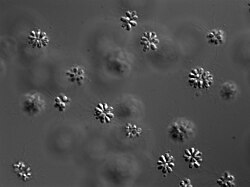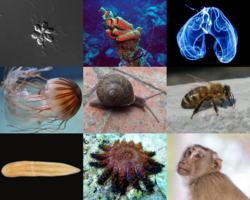Tillite (Elatina Formation, Neoproterozoic; Enorama Creek section, Flinders Ranges, South Australia) 9
Tillite is a lithified till, a poorly-sorted, coarse-grained, non-bedded glacial deposit. Tills form as either continental glaciers or alpine glaciers advance and retreat. The glacial debris seen here was reworked by fluvial action, so they are actually glaciofluvial deposits.
This reddish tillite is part of South Australia's Elatina Formation and formed about 640 million years ago, during the Marinoan Glaciation. The Marinoan was one of two or three global or near-global ice ages called "Snowball Earth Glaciations". Laterally, along strike, the Elatina Formation has tidalites (see elsewhere in this photo album), which only form at sea level. Paleomagnetic analysis shows that this area was within 5° of latitude of the paleoequator. In other words, glaciers were present at sea level at the equator. That can only happen during an extreme ice age. Stratigraphic evidence from sites around the globe also indicate a widespread ice age.
Snowball Earth events were the most significant ice ages ever. The most extreme models describing Snowball Earth have glacial ice completely covering all continents and all oceans, even at the equator. Some models, called “Slushball Earth”, have Earth’s equatorial oceanic areas not completely frozen over. Each Snowball Earth Glaciation was followed by a super-greenhouse climate. The resulting sedimentary record of these “freeze-fry” events typically consists of glacial tillites and overlying cap carbonates. These units are preserved at many localities on Earth, including the section seen here.
In this area, the reddish tillite unit is about 300 meters thick and has an conformably-overlying cap carbonate. The tillite has clasts with glacial striations.
Stratigraphy: Elatina Formation, Marinoan, ~uppermost Cryogenian, top of the middle Neoproterozoic
Locality: outcrop along Enorama Creek, Brachina Gorge Geologic Trail, Flinders Ranges National Park, South Australia (vicinity of 31° 19.892’ South latitude, 138° 38.001’ East longitude)
See info. at: en.wikipedia.org/wiki/Marinoan_glaciation and
en.wikipedia.org/wiki/Snowball_EarthRelevante Bilder
Relevante Artikel
ChoanozoaZu der Gruppe der Choanozoa gehören alle vielzelligen Tiere (Metazoa) und ihre nächsten Verwandten, die Kragengeißeltierchen (Choanoflagellata). Es zählen sämtliche Lebensformen dazu, die den Zelltyp der Kragengeißelzelle (Choanocyt) ausbilden oder deren Vorfahren wahrscheinlich einmal diesen Zelltyp ausgebildet haben. .. weiterlesen









